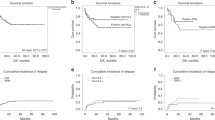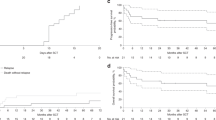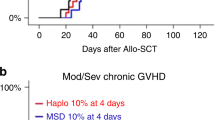Abstract
Twenty-six cases of B cell lymphoproliferative disorder (BLPD) were identified among 2395 patients following hematopoietic stem cell transplants (HSCT) for which an overall incidence of BLPD was 1.2%. The true incidence was probably higher, since 9/26 of the diagnoses were made at autopsy. No BLPD was observed following autologous HSCT, so risk factor analyses were confined to the 1542 allogeneic HSCT. Factors assessed were HLA-mismatching (⩾1 antigen), T cell depletion (TCD), presence of acute GvHD (grades II–IV), donor type (related vs unrelated), age of recipient and donor, and underlying disease. Factors found to be statistically significant included patients transplanted for immune deficiency and CML, donor age ⩾18 years, TCD, and HLA-mismatching, with recipients of combined TCD and HLA-mismatched grafts having the highest incidence. Factors found to be statistically significant in a multiple regression analysis were TCD, donor age and immune deficiency, although 7/8 of the patients with immunodeficiencies and BLPD received a TCD graft from a haploidentical parent. The overall mortality was 92% (24/26). One patient had a spontaneous remission, but subsequently died >1 year later of chronic GVHD. Thirteen patients received therapy for BLPD. Three patients received lymphocyte infusions without response. The only patients with responses and long-term survival received alpha interferon αIFN). Of seven patients treated with αIFN there were four responses (one partial and three complete). These data demonstrate thatαIFN can be an effective agent against BLPD following HSCT, if a timely diagnosis is made.
This is a preview of subscription content, access via your institution
Access options
Subscribe to this journal
Receive 12 print issues and online access
$259.00 per year
only $21.58 per issue
Buy this article
- Purchase on Springer Link
- Instant access to full article PDF
Prices may be subject to local taxes which are calculated during checkout
Similar content being viewed by others
Author information
Authors and Affiliations
Rights and permissions
About this article
Cite this article
Gross, T., Steinbuch, M., DeFor, T. et al. B cell lymphoproliferative disorders following hematopoietic stem cell transplantation: risk factors, treatment and outcome. Bone Marrow Transplant 23, 251–258 (1999). https://doi.org/10.1038/sj.bmt.1701554
Received:
Accepted:
Published:
Issue Date:
DOI: https://doi.org/10.1038/sj.bmt.1701554
Keywords
This article is cited by
-
Impact of antithymocyte globulin usage and risk stratification for posttransplant lymphoproliferative disorders in aplastic anemia patients after allogeneic hematopoietic cell transplantation
Bone Marrow Transplantation (2024)
-
Post-transplantation lymphoproliferative disorder after haematopoietic stem cell transplantation
Annals of Hematology (2021)
-
Epstein–Barr virus reactivation after allogeneic hematopoietic stem cell transplantation: multifactorial impact on transplant outcomes
Bone Marrow Transplantation (2020)
-
Lymphoma Secondary to Congenital and Acquired Immunodeficiency Syndromes at a Turkish Pediatric Oncology Center
Journal of Clinical Immunology (2016)
-
Donor cell-derived acute promyelocytic leukemia after allogeneic hematopoietic stem cell transplant
Annals of Hematology (2015)



